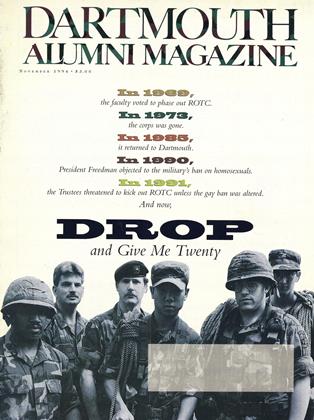For years, free-market economists have been telling us that low wages go with low unemployment and high wages with high unemployment. When labor is scarce, in other words, it gets more expensive. Everybody knows that, right?
Well, we're all wrong, according to a new study by Dartmouth economist David Blanchflower and Andrew Oswald, a former Dartmouth prof now based at the London School of Economics. And this was no mean study; the two economists crunched numbers involving 12 nations, 3 0 years, and 3.5 million people. "Macro economists have always thought there is a stable relationship between wage levels and unemployment," explains Blanchflower. "But they thought it was a positive rather than a negative relationship—that when one goes up so does the other, because if wages go high enough, the number of individuals wanting to supply their labor exceeds the number that can be employed and the result is unemployment. This shows just the opposite."
Why should this happen? The authors refuse to speculate, saying that is a matter for further study. But Blanchflower offers this tidbit. "The curve that we have found would not have been predicted by the current generations of economics textbooks," he says. "But it is exactly that predicted by a new and still controversial branch of macroeconomics. That theory has not reached the textbooks yet, but when it does, those texts will have to be rewritten." In the meantime economic revisionists should look for Blanchflower and Oswald's new book, The Wage Curve, to be published this winter by MIT Press.
 View Full Issue
View Full Issue
More From This Issue
-
 Cover Story
Cover StoryYou Thougnt Rotc was Dead?
November 1994 By Frederic J. Frommer -
 Feature
FeatureLessons of a Legacy
November 1994 By Peter Blodgett '74 -
 Cover Story
Cover StoryFOOTNOTES TO A TRAGEDY
November 1994 By John Scotford '38 -
 Feature
FeatureTHE GAME PEOPLE
November 1994 By Ken Burns -
 Class Notes
Class Notes1980
November 1994 By Daniel Zenkel -
 Article
ArticleEssayists and Solitude
November 1994 By James O. Freedman
Article
-
 Article
ArticleACTIVITIES OF PRESIDENT HOPKINS
April 1917 -
 Article
ArticleRaclin Marine Head
June 1944 -
 Article
ArticleCited as Class Agent
May 1952 -
 Article
ArticleDartmouth Night is...
OCTOBER 1988 -
 Article
ArticleDARTMOUTH LAWYERS IN NEW YORK
March 1941 By Laurence W.Lougee '29. -
 Article
ArticleTHE UNDERGRADUATE CHAIR
March 1960 By WILLIAM G. BATT '60

